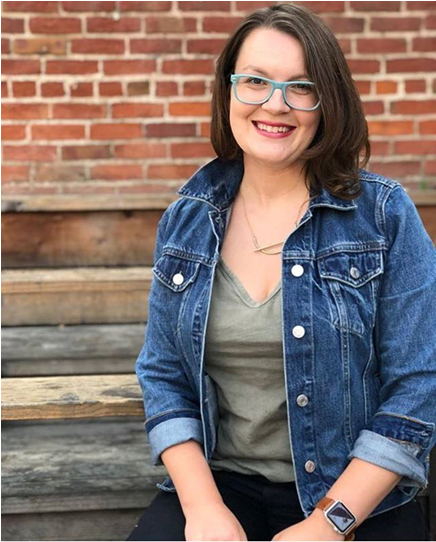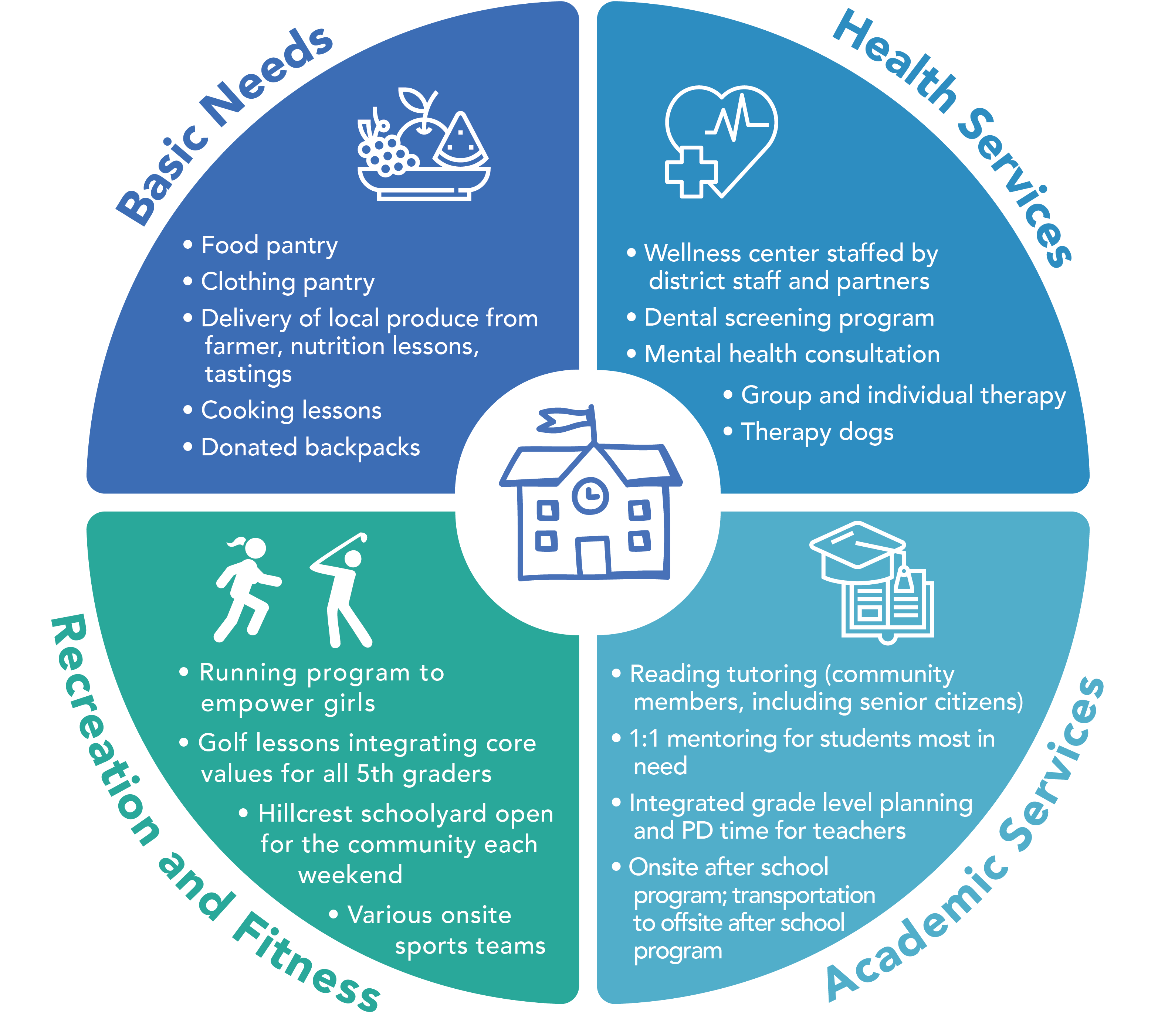In our work with schools, we often learn about innovative ways that educators and others can support students and their families. Our Student Behavior Research Team’s work with Project SECURE, funded by the National Institute of Justice, brought us to Hillcrest Elementary School, a place where students receive much more than academic instruction. Hillcrest, which is located in southeast San Francisco, uses a community school approach to bring local leaders and organizations together to offer comprehensive, wide-ranging supports and opportunities for the whole school community during and after school hours. San Francisco Unified School District supports this approach by investing in social workers and nurses to serve every school across the city.

Gabby Theobald-Anderson
Hillcrest Elementary School serves about 440 students in grades K-5, with Latino, Asian, and African American students representing the largest demographic groups. Many families of Hillcrest students experience ongoing challenges with everyday life, such as housing instability, the high cost of living in San Francisco, low-paying and part-time employment, limited multilingual supports, and a lack of affordable fresh food markets and health care services providers, particularly dentists. Many parents work long hours at multiple jobs without the means to engage in their children’s school experiences in traditional ways, more than 90% of the students receive free and reduced-price meals, and the PTA works with a small budget and limited resources.
Despite these challenges, Hillcrest Elementary School is a vibrant neighborhood hub, hosting 35+ community partners that offer services and supports to help Hillcrest families meet daily demands, grow academically, stay emotionally and physically healthy, connect with their neighbors, and thrive. We spoke with Hillcrest’s school social worker, Gabby Theobald-Anderson, about what it means to be a community school and about the inventive ways that Hillcrest and the larger community are working together to help students and their families lead healthier and happier lives.
What is a community school?
Community schools are public schools that bring local partners together to share resources and support students and their families across all aspects of their lives. The Coalition for Community Schools describes a community school as “…the center of its neighborhood, uniting families, educators, and community partners to provide all students with top-quality academics, enrichment, health and social services, and opportunities to succeed in school and in life.”
Gabby similarly described being a part of a community school in this way: “We’re not just responsible for kids’ academic progress, but… for fulfilling all of the needs the family has in order for the students to be supported enough to thrive academically and socio-emotionally. If we don’t have resources on site, we connect them to resources in the community. The school should be the center hub of the community.”
Community schools enable the larger community to invest in and engage with students and families, who in turn become active school and neighborhood citizens. Gabby emphasized that being a community school means creating a shared vision of responsibility for the academic and non-academic needs of students: “It’s not a program that you can buy. It’s a set of beliefs that your school community needs to come to that lead to practices and partnerships.”
The Hillcrest community adopted this approach in 2006, when it received a grant from California’s Healthy Start program, an initiative of the California Department of Education that supported the linkage of school-community programs and activities. In the years since Healthy Start ended in 2012, Hillcrest has maintained its mission to connect with the community to leverage needed resources for students and families.
What kinds of services can community schools provide?
Through tenacity and creative networking, Gabby and her Hillcrest colleagues have established relationships with representatives from local nonprofits, businesses, government agencies, and colleges and universities. Together, these partners provide a wide range of services to Hillcrest that would be prohibitive for the school to purchase on its own. In addition to offering services and resources that directly benefit Hillcrest’s children and families, some partners also write grants at no cost to the school, paving the way for more relationship building that translates into more benefits and resources for the Hillcrest community.
Examples of services and resources provided by Hillcrest’s partners

Combining resources from multiple partners in imaginative ways can make a big difference. Gabby gave one example of how various Hillcrest community partners came together to fill a need for more clothes for Hillcrest families:
There were only a small number clothing pantries in the city, and all had very limited hours: “You had to call and make an appointment, or … the message was only in English, or the clothing pantry was only open Tuesday through Thursday from 10 am to 1 pm.”
Gabby indicated that these limitations meant that Hillcrest families, especially parents working multiple jobs, could not take advantage of the clothing pantries.
Around the time that Gabby identified the lack of convenient clothing closets for Hillcrest families, the school had a volunteer day and received a $200 donation from a corporate sponsor. Gabby used the donation to buy clothing racks. In addition, the partner who runs Hillcrest’s dental screening program mentioned that her agency also had additional clothing racks, left over from a fundraiser, that they could donate.
Knowing that there were bags of unclaimed clothes from Hillcrest’s lost and found, Gabby reached out to a local company that picks up and delivers laundry.
The laundry company agreed to wash and return the lost and found clothing on an ongoing basis. Later Gabby reached out on a local San Francisco Facebook group asking for donations and reached a number of other schools and a corporate partner that continued to do ongoing clothing drives.
“We put it on the racks, and it went like wildfire. Now we have a couple of other local schools and families that do regular clothing drives for us, for adults and children every few months. It’s here, co-located, our families use it… It was …one of those things that takes some backend work to start and maintain.”
What does it take to be a community school?
Building and sustaining a community school approach is hard work that requires devoted staff, generous donations, and a community-wide commitment to care for its members. Having a point person who understands the school population and can identify opportunities for community partners to provide needed supports is critical. To determine the specific needs of Hillcrest families, Gabby maintains strong relationships with the teachers “who are on the front line” and with school administration, with students and families, and she collaborates with Hillcrest’s after school program coordinator, a YMCA employee, who has daily access to the school population and also maintains and coordinates relationships with many of Hillcrest’s community partners.
Gabby also works to bridge the organizational differences between schools and community organizations and to target community resources strategically. Gabby said, “The school is its own entity, it’s a bureaucracy, and these non-profits are really coming from different organization structures and norms. So it’s just really helpful to have a go-between — who doesn’t have to try to run the school, who doesn’t have to teach – and who has some of that capacity to help the two organizations learn how to work together and to be sure that the resources we bring in are what our population actually needs.” The school also hosts quarterly meetings of the full partnership, which provide opportunities to discuss needs, connect resources, and share new ideas.
Gabby reported that some community partners are so integrated into the school that new teachers sometimes don’t know who is a school staff member and who is a community partner. For Hillcrest students, there is no shortage of caring neighbors.
For more information, including guidance on starting a community school and measuring its impact, and for profiles of other model community schools, see Coalition for Community Schools.
Additional resources:
- Policy and implementation guide for educators, policymakers, and community groups looking to advance community school strategies (Source: Partnership for the Future of Learning)
- The six pillars of community schools toolkit NEA resource guide for educators, families, and communities (Source: National Education Association, NEA)
- What is a community school? brochure (Source: The American Federation of Teachers, AFT)
Topics: Partnerships and family engagement School-Community Partnerships
Tags: Community schools
